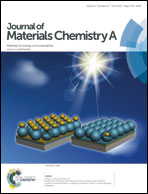Construction of PANI–cellulose composite fibers with good antistatic properties†
Abstract
For the first time, novel polyaniline (PANI)–cellulose filament fibers have been successfully spun from hydrophobic PANI and hydrophilic cellulose complex solution dissolved in aqueous containing 7 wt% NaOH/12 wt% urea as the solvent by wet-spinning. The composite fibers had a circular cross-section and homogenous surface structure, as a result of good miscibility between PANI and cellulose associated through hydrogen bonds. Moreover, at low PANI content, the composite fibers realized a transition from an insulator to a semiconductor. This work has provided a simple and eco-friendly avenue for the production of PANI composite fibers that have great potential applications in the antistatic textile and military industries.


 Please wait while we load your content...
Please wait while we load your content...